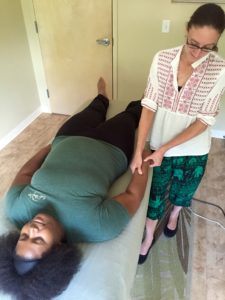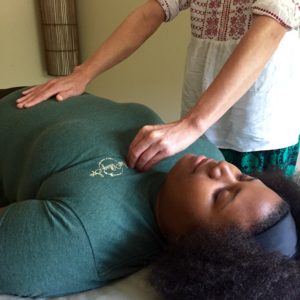
Our licensed massage therapist, Jamee, has been incorporating more acupressure techniques into her massage in recent months and her clients are enjoying excellent results. I’ve had the privilege of experiencing firsthand the great work she can do with acupressure and am thrilled she agreed to share more with our readers.
The info contained below is by our expert, Jamee. Enjoy! ~Cassie
Acupressure Explained:
According to Chinese Medicine, qi is the vital life force of the body, which, when flowing freely nurtures, sustains, and heals. The qi is directed throughout the body by 12 channels called meridians. Each of these meridians then direct the qi to their corresponding organ points, and it is at these points that blockage (usually due to trauma of a physical, emotional, or mental nature) or stagnation occurs. It is stated that pain is the manifestation of stagnant or sluggish qi. Acupressure is the practice of tonifying or depleting excess energy at these points as needed, thus creating a harmonious balance between mind and body, yin and yang.
Acupressure v. Acupuncture:
The practice of acupuncture is 5000 years old and the first needles were made out of stone. Acupressure predates acupuncture and even massage by many generations as one of the first forms of medicine. While acupuncture is derived from acupressure, employing the same points and meridians, acupuncture uses various needling techniques requiring a more extensive clinical education. Acupressure relies solely on finger pressure and is non invasive. I have over 100 hours of training in acupressure and have spent the last two years adapting my massage technique to best relieve blockages and stimulate the inherent self healing capabilities of each client I work with.
 What is an acupressure session like?
What is an acupressure session like?
While acupressure points are potent and can be used singly, there are many possible sequences to choose from so I can personalize your treatment to specific needs. During a treatment, you will remain fully clothed, face up on the massage table, while I perform a sequence connecting different points and meridians along the right and left sides of the body. I will check in about pressure and encourage you to speak up if you experience any discomfort.
Pressure points are generally tender, but should not cause actual pain. A quiet, relaxed mind and body is essential for the work. It is just as important for the conscious mind to take a break as it is for me to focus on the work. My clients report a state of deep relaxation, well-being, and even lucid dreaming.
While I use acupressure in each massage, I am very excited to offer it as a stand alone treatment as the effects of a deeper, more focused application are much more pronounced and treatment possibilities much broader. Even so, acupressure is much like any other bodywork/self care regimen in that you get out of it what you put into it. Most imbalances take time to build up, so therefor cannot be permanently eliminated in one session. As acupressure is cumulative, you can expect relief after the first session, but depending on the nature and severity of the problem being addressed, it may take up to 3-5 treatments to achieve lasting results. At the end of each session, we will work together to develop a self care plan for you, and it is important to carry through on that for optimal results.
As acupressure focuses on restoring and maintaining the homeostasis throughout the body and mind, any number of conditions will benefit including, but by no means limited to:
- swollen joints/arthritis/rheumatism
- joint and muscle pain
- tendonitis/bursitis
- depression and anxiety
- lethargy/adrenal fatigue
- insomnia
- Sexual disorders
- headaches/chronic migraines
- chronic conditions that may not be responding to traditional forms of treatment
- many more!
Thank you for taking time to learn more about Acupressure! Jamee Williams, LMT
Sign me up!
If you wish to schedule an acupressure appointment with Jamee, call (515) 309-2904 and request the “custom Eastern Massage” in 60 or 80 minute length. This is not available with an online booking. You will want to wear comfortable clothing (like gym or yoga clothes) as you will remain fully clothed. Jamee is currently our only massage therapist offering this service, which is why it is not available for online booking.




 The best approach to a tantrum (or trigger point) is to stay calm. Instead of meeting aggression with aggression, a good therapist will calmly try to get to the root of the problem. It might take a bit of exploration from what seems obvious. For example, a tantrum in a grocery store might seem like it is about not getting a candy bar, but the root of the tantrum might be a missed nap. Just like a painful muscle in your calf might be caused by a tight muscle in your gluts.
The best approach to a tantrum (or trigger point) is to stay calm. Instead of meeting aggression with aggression, a good therapist will calmly try to get to the root of the problem. It might take a bit of exploration from what seems obvious. For example, a tantrum in a grocery store might seem like it is about not getting a candy bar, but the root of the tantrum might be a missed nap. Just like a painful muscle in your calf might be caused by a tight muscle in your gluts.